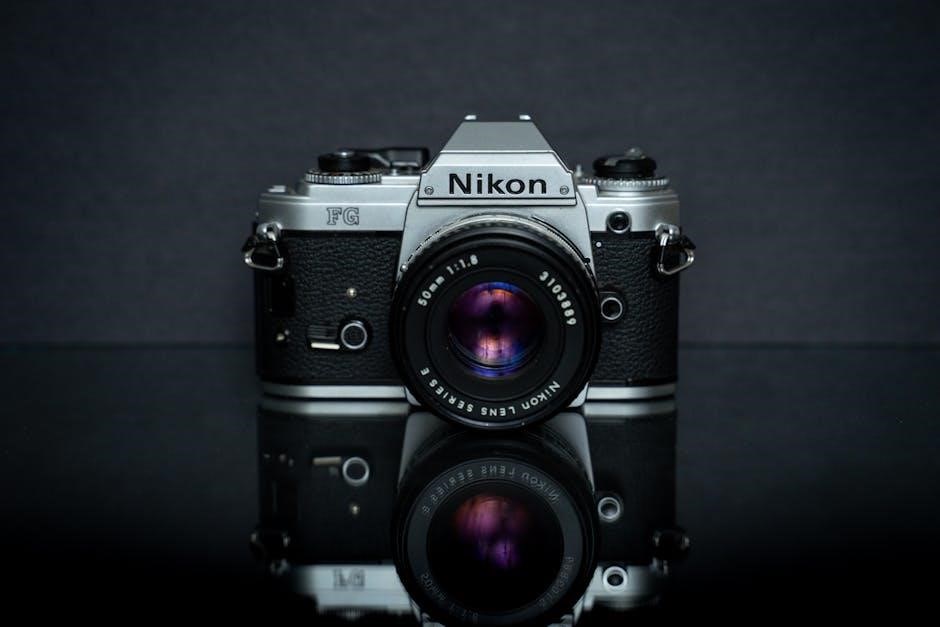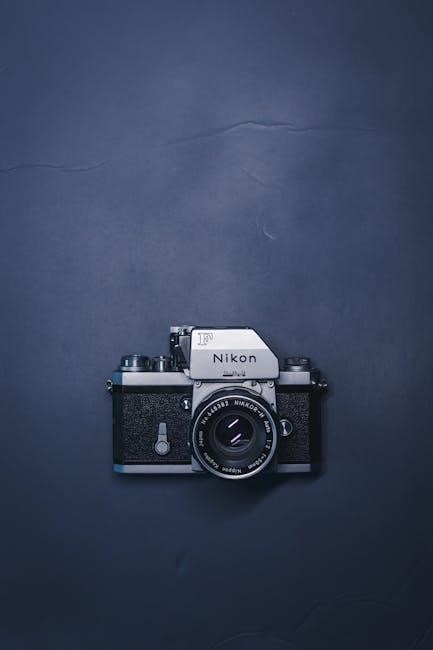Nikon D3000 Manual: A Comprehensive Guide

Unlock the full potential of your Nikon D3000 with this comprehensive guide. Designed for both beginners and experienced users, this manual covers everything from basic operations to advanced photography techniques. Learn how to master your camera’s features and capture stunning images.
The Nikon D3000 is a digital single-lens reflex (DSLR) camera designed for both novice and enthusiast photographers. Released as part of Nikon’s DX format line, the D3000 offers a user-friendly interface and a range of features that make it an excellent entry-level camera. Its key selling point is the “Guide Mode,” which assists beginners in understanding camera settings and photographic techniques. With its 10.2-megapixel sensor, the D3000 captures detailed images suitable for printing and sharing. The camera is compatible with a wide range of Nikon F-mount lenses, providing versatility for various shooting scenarios. The D3000 also features a built-in flash and supports SD and SDHC memory cards for convenient storage. Its lightweight design and comfortable grip make it easy to handle, while the 3-inch LCD screen allows for easy image review. The D3000 provides a solid foundation for learning photography and exploring creative possibilities. Whether you’re capturing family moments or landscapes, the Nikon D3000 offers a blend of simplicity and performance. Its intuitive controls and helpful features make it an ideal choice for those new to DSLR photography.
Downloading the Nikon D3000 Manual
Accessing the Nikon D3000 manual is a straightforward process. The manual, available in PDF format, provides comprehensive instructions on using every feature of your camera. To download it, begin by visiting the official Nikon website or a trusted source for camera manuals. Navigate to the support section and search for the D3000 model. You’ll typically find the manual listed under “Downloads” or “Documentation.” Ensure you select the correct language version for your convenience, with options like English and others available. Before downloading, you might need to agree to a download agreement, which outlines the terms of use for the manual. Once downloaded, the PDF can be opened on your computer, tablet, or smartphone using a PDF reader like Adobe Acrobat Reader. The manual is a valuable resource for understanding camera settings, troubleshooting issues, and exploring advanced techniques. Keep a copy on your devices for easy reference, whether you’re at home or on the go. Regularly consulting the manual will enhance your photography skills and ensure you get the most out of your Nikon D3000. Enjoy exploring the detailed guidance it offers!
Navigating the Nikon D3000 User Interface
Understanding the Nikon D3000’s user interface is crucial for efficient camera operation. The interface consists of several key components, including the LCD screen, control buttons, and menu system. The LCD screen displays essential information such as shooting mode, shutter speed, aperture, ISO, and battery level. The control buttons, strategically placed around the camera body, provide quick access to frequently used settings like exposure compensation, white balance, and focus mode. The menu system, accessible via a dedicated button, offers a comprehensive range of options for customizing camera settings and functions. Navigating the menu is done using the multi-selector, allowing you to scroll through options and make selections. Familiarize yourself with the layout of the buttons and the structure of the menu to quickly adjust settings in different shooting scenarios. Pay attention to the icons and symbols displayed on the LCD screen, as they provide visual cues about the current camera settings. Regular practice and exploration will enhance your familiarity with the user interface, enabling you to make confident adjustments and capture the perfect shot. Understanding how to navigate these elements will unlock the full potential of your D3000.

Understanding the Guide Mode
The Nikon D3000 features a unique Guide Mode, specifically designed to assist beginner photographers in learning the basics of photography. Unlike the standard automatic modes, Guide Mode offers step-by-step instructions directly on the camera’s LCD screen. This interactive tutorial guides users through various shooting scenarios, explaining the effects of different settings on the final image. The Guide Mode presents options in plain language, eliminating technical jargon and making it easy to understand the concepts involved. You can select from a variety of shooting options, such as “Take pictures softer” or “Photograph distant subjects,” and the camera will guide you through the necessary adjustments to aperture, shutter speed, and ISO. This hands-on approach allows users to see the immediate impact of their settings, reinforcing their understanding of fundamental photographic principles. By following the instructions provided in Guide Mode, beginners can quickly learn how to control depth of field, capture motion, and improve their overall image quality. The Guide Mode also offers helpful tips and explanations, turning the D3000 into a personal photography tutor. Embrace this feature to build confidence and develop a solid foundation in photography.
Safety Precautions
Before using your Nikon D3000, it is crucial to familiarize yourself with the necessary safety precautions to prevent damage to the camera, personal injury, or other potential hazards. Never disassemble or modify the camera; doing so could result in electric shock or malfunction. Avoid using the camera in excessively humid or dusty environments, as this can damage internal components. Keep the camera away from water and other liquids to prevent short circuits and corrosion. Do not expose the camera to extreme temperatures, such as direct sunlight for extended periods, as this can cause overheating and damage to the LCD screen or other parts. When using the flash, be mindful of the distance to your subject and avoid flashing directly into people’s eyes, as this can cause temporary vision impairment. Always use the specified battery type and charger for the D3000 to prevent battery leakage, overheating, or explosion. When transporting the camera, ensure it is securely packed to avoid accidental damage. Regularly clean the camera body and lens with a soft, dry cloth to remove dust and fingerprints. By following these safety precautions, you can ensure the longevity and proper functioning of your Nikon D3000.

Using SD and SDHC Memory Cards
The Nikon D3000 is compatible with both SD (Secure Digital) and SDHC (Secure Digital High Capacity) memory cards. These cards serve as the primary storage for your photos and videos, so understanding their proper use is essential. Before inserting a memory card, ensure the camera is turned off to prevent data corruption. Gently insert the card into the card slot until it clicks into place. To remove the card, turn off the camera, push the card in slightly to release it, and then pull it out. Avoid forcing the card in or out, as this can damage the card slot or the card itself. The D3000 supports SDHC cards up to 32GB, allowing for ample storage of high-resolution images. When choosing a memory card, consider the speed class, which indicates the card’s write speed. A faster write speed is beneficial for shooting continuous bursts of photos or recording videos. Regularly format your memory card using the camera’s formatting option to ensure optimal performance and prevent file system errors. Backing up your photos regularly to a computer or external hard drive is recommended to avoid data loss. Avoid exposing memory cards to extreme temperatures, humidity, or static electricity, as this can damage the card and its contents.
Basic Camera Operations
Familiarizing yourself with the basic operations of the Nikon D3000 is the first step to capturing great photos. Start by attaching a lens to the camera body, ensuring it clicks securely into place. Power on the camera using the power switch, typically located near the shutter button. The main command dial allows you to select different shooting modes, such as Auto, Program, Aperture Priority, Shutter Priority, and Manual. Auto mode is ideal for beginners, as it automatically adjusts the camera settings for optimal results. The shutter button is used to take photos; a half-press activates the autofocus system, while a full press captures the image. The D3000 features a built-in flash, which can be activated or deactivated using the flash button. The LCD screen displays important information, such as the shooting mode, shutter speed, aperture, and ISO. Use the menu button to access the camera’s settings and customize various options. The directional pad allows you to navigate the menu system and select different settings. Review your photos by pressing the playback button. Adjust the diopter setting on the viewfinder to ensure a clear view. Understanding these basic operations will provide a solid foundation for exploring the D3000’s more advanced features.

Exploring Key Features
The Nikon D3000 boasts several key features designed to enhance your photography experience. The Guide Mode is a standout, offering step-by-step instructions for various shooting scenarios, perfect for beginners. The 10.2-megapixel sensor delivers high-quality images with excellent detail. The camera’s autofocus system ensures sharp and clear photos, even in challenging lighting conditions. The built-in flash provides additional illumination when needed, and its settings can be adjusted for optimal results. The D3000 is compatible with a wide range of Nikon lenses, allowing you to expand your creative possibilities. The camera supports both SD and SDHC memory cards, providing ample storage for your photos and videos. The ISO range can be adjusted to suit different lighting conditions, from bright daylight to low-light environments. The D3000 also features various scene modes, such as Portrait, Landscape, and Sports, which automatically optimize the camera settings for specific subjects. The image review function allows you to quickly assess your photos and make adjustments as needed. Furthermore, the camera’s intuitive menu system makes it easy to navigate and customize the settings to your preferences. These key features make the Nikon D3000 a versatile and user-friendly camera for photographers of all skill levels.
Troubleshooting Common Issues
Like any electronic device, the Nikon D3000 can sometimes encounter issues. One common problem is the camera not turning on. Ensure the battery is properly charged and correctly inserted. If the issue persists, try using a different battery. Another frequent concern is blurry images. This can be caused by incorrect focus settings or camera shake. Use the autofocus feature and consider using a tripod for stability. Error messages can also appear on the LCD screen. Consult the manual to identify the specific error and follow the recommended troubleshooting steps. If the memory card is not recognized, ensure it is properly inserted and compatible with the camera. Formatting the card may also resolve the issue, but remember to back up your photos first. In some cases, the camera may freeze or become unresponsive. Try removing the battery for a few minutes to reset the system. If the built-in flash is not working, check the flash settings in the menu. Sometimes, the flash may be disabled or set to a specific mode. If you encounter difficulty downloading images to your computer, ensure the USB cable is securely connected and the correct drivers are installed. If all else fails, consider contacting Nikon support or consulting a professional camera technician for assistance. Regular maintenance and careful handling can help prevent many of these common issues.
Advanced Photography Techniques
Once you’ve mastered the basics of your Nikon D3000, it’s time to explore advanced photography techniques. One such technique is mastering manual mode, allowing full control over aperture, shutter speed, and ISO for creative effects. Experiment with different aperture settings to achieve shallow depth of field for portraits or wide depth of field for landscapes. Learn to use shutter speed to freeze motion or create motion blur. Another advanced technique involves using different metering modes to accurately expose your images in challenging lighting conditions. Spot metering is useful for subjects with high contrast, while matrix metering is suitable for general scenes. Understanding and utilizing different focusing modes, such as continuous autofocus (AF-C), can significantly improve your ability to capture sharp images of moving subjects. Explore the use of external flashes and diffusers to control lighting and reduce harsh shadows. Experiment with composition techniques like the rule of thirds, leading lines, and symmetry to create visually appealing images. High dynamic range (HDR) photography involves combining multiple exposures to capture a wider range of tones. Practice long exposure photography using a tripod and neutral density filters to create surreal effects with water or clouds. Finally, explore the world of macro photography using a dedicated macro lens to capture stunning close-up details. Mastering these techniques will elevate your photography skills and allow you to create truly remarkable images.
Maintaining Your Nikon D3000
Proper maintenance is crucial to ensure the longevity and optimal performance of your Nikon D3000. Regularly clean the camera’s exterior with a soft, dry cloth to remove dust, fingerprints, and smudges. Use a blower brush to gently remove dust from the lens and sensor. Avoid using harsh chemicals or abrasive materials, as they can damage the camera’s finish. Store your camera in a cool, dry place, away from direct sunlight and extreme temperatures. When not in use, remove the battery to prevent corrosion and extend its lifespan. Periodically check the lens for scratches or damage, and clean it with a lens cleaning solution and microfiber cloth; Inspect the camera’s buttons and dials for smooth operation, and address any issues promptly. Protect the LCD screen with a screen protector to prevent scratches and damage. If you notice any unusual noises or malfunctions, consult a qualified technician for repair. Regularly update the camera’s firmware to ensure compatibility with new lenses and accessories. When changing lenses, be careful to avoid dust and debris entering the camera body. Consider using a camera bag or case to protect your camera during transport. By following these simple maintenance tips, you can keep your Nikon D3000 in excellent condition and enjoy years of reliable performance.
